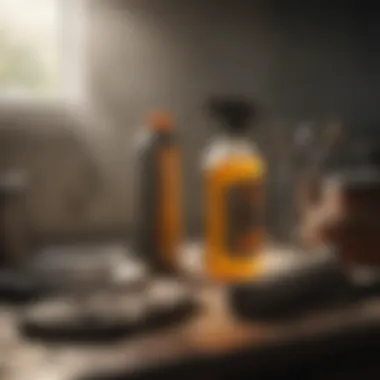Understanding Mold's Effect on Clothing and Solutions


Intro
Mold, a word that can send shivers down anyone's spine, is more than just a household nuisance. It’s a sneaky little organism that can wreak havoc on your clothes and, in turn, on your health. If you've ever found your favorite shirt with mysterious black spots or a musty odor wafting from an old jacket, you know the feeling well. Mold thrives in damp, dark places and can make its way into your wardrobe before you even know it.
This article aims to shed light on how mold develops on fabrics, the associated health risks, and practical methods to fight back. As we dive into this topic, we'll look at the conditions that create a mold paradise and spot the signs that could indicate a hidden issue in your closet. We will also cover effective strategies for treatment and prevention, ensuring you’re armed with knowledge to combat mold and preserve your clothes. It's high time we tackle this topic head-on and equip ourselves to keep both our wardrobe and our well-being in tip-top shape.
Preamble to Mold and Its Relevance to Clothing
Understanding mold is crucial, especially when it comes to our clothing. It often lurks unnoticed in closets and storage spaces, waiting for the right conditions to make its presence known. Mold not only damages fabric but can also pose serious health risks. Thus, recognizing why this topic holds significance is the first step in addressing everything related to mold.
Mold thrives in specific conditions, like high humidity and warmth, both of which can be prevalent in homes or storage areas. When it starts growing on clothing, it does more than just create unsightly stains; it can also weaken the fibers, leading to irreversible damage. Knowing how to spot these issues early on can save not just your favorite shirts but also your well-being.
The relevance of this knowledge extends further than mere fabric care.
- Health Risks. Exposure to mold can lead to various health issues, particularly for sensitive individuals, such as those with asthma or weakened immune systems.
- Material Preservation. Mold often feasts on natural fibers like cotton or wool, making it necessary to act promptly.
- Aesthetic Concerns. Stains from mold are tough to remove, and moldy clothing is typically unpleasant to wear.
In short, this information arms people with the necessary know-how to combat mold and safeguard their clothing and health. The goal here is simple: equip yourself with the tools to understand mold's behavior, recognize its signs, and implement strategies that can mitigate its impact. This way, you can keep your wardrobe fresh and healthy.
Conditions Favoring Mold Growth on Fabrics
When discussing mold and its relationship with clothing, it becomes crucial to understand the conditions that favor its development. Mold can wreak havoc on textiles, not only damaging the fabric but also posing serious health risks. Environmental factors, such as moisture, temperature, and material composition, all play pivotal roles in determining whether mold sets up shop on your favorite garments. Having a solid grasp of these elements allows individuals to mitigate risks and preserve both their clothing and well-being.
Moisture and Its Role in Mold Development
This is perhaps the most significant factor contributing to mold growth. Mold spores exist almost everywhere in nature, but they require specific conditions to thrive. High humidity levels, particularly those exceeding 60%, create a perfect breeding ground for mold. When water seeps into fabrics, whether from washing or environmental exposure, it can lead to moisture accumulation. Even the slightest dampness left after washing or spills can be enough for mold to develop if not dried out promptly.
Moreover, dark, poorly ventilated areas tend to retain moisture longer, creating what can be thought of as a luxury hotel for fungi. Think about the last time you tucked away a damp raincoat in the back of your closet or stored clothes in a humid basement; these situations are prime catnip for mold. Without implementing proactive measures—like ensuring proper airflow and drying items thoroughly—those fabrics might just end up as the exhibition hall for mold growth.
Temperature and Environmental Factors
The interplay of temperature and environmental conditions is another pivotal aspect of mold growth. Mold thrives in warmer temperatures, typically ranging from 77°F to 86°F (25°C to 30°C). This means areas in your home that are not air-conditioned, or maybe poorly insulated, such as attics or basements, might become breeding grounds. Conversely, cooler temperatures can inhibit growth, but they don’t outright stop mold spores from existing.
What’s more, the combination of warm and humid air is particularly dangerous. For instance, if you live in a region notorious for hot summers, and your laundry room lacks ventilation, you’re inviting mold to come and stay. This connection between temperature and mold growth highlights the need for careful monitoring of home climates and garments.
Material Composition and Vulnerability
Mold doesn't discriminate when it comes to textiles; however, some materials are more susceptible to mold growth than others. Natural fibers like cotton, wool, and silk are particularly vulnerable due to their porous nature, which can absorb moisture far more readily than synthetic materials like polyester and nylon. Therefore, clothing that is primarily made from these natural fibers may require extra care when it comes to storage and cleaning.
It’s also essential to consider the way these fabrics are treated. Certain finishes can make materials more mold-resistant, but not all fabrics come equipped with these features. Choosing higher-quality materials when shopping can significantly decrease the likelihood of encountering mold-related issues down the line. It’s wise to be vigilant about the conditions under which these textiles are kept, as even the best clothing can fall prey to mold if left in unfavorable circumstances.
In Summary: Understanding the environmental factors that favor mold growth can make all the difference in preserving clothing and maintaining a healthy household. Actively managing moisture, temperature, and material types creates a mold-free environment where your clothing can flourish.
Identifying Mold on Clothing


Understanding how to identify mold on clothing is crucial in managing its impact. Mold can be sneaky, lurking in corners and under layers, making it hard to detect until there is already significant damage. Mold not only ruins the aesthetic of your favorite clothes but can also pose health risks. Knowing what to look for can save you time and trouble, ensuring that your garments stay fresh and your family remains safe.
Visual Indicators of Mold Presence
Mold often leaves physical traces that can be spotted if you know what to look for. Here are some common visual signs:
- Discoloration: Look for green, black, or even white patches on the fabric. These could be molds taking residence.
- Spotting or Staining: Any irregular spots, especially ones that appear fuzzy or hairy, could indicate mold growth. It might look like a splatter, dot, or streak on your clothing.
- Texture Changes: The fabric may feel different in areas where mold has taken hold. It might become brittle or take on a spongy feeling depending on the depth of the infestation.
- Dust or Debris: Sometimes, a powdery substance might accompany visible mold. This could indicate mold spores, which can easily contaminate other fabrics if not addressed quickly.
If you come across any of these signs, it's vital to take action. Ignoring visible mold can lead to it spreading further, compromising not just your clothing but other items stored nearby.
Odor as a Sign of Mold Growth
Besides the visual clues, a distinct odor can also serve as an alarm bell for mold presence. Mold commonly develops a musty smell that can be hard to overlook. Here’s how to recognize this warning sign:
- Musty Smell: A damp, earthy scent in your closet or storage area may not just be the result of humidity. It's likely mold saying hello.
- Persistent Odor: If the clothing has been washed but still carries that funky smell, think twice before dismissing it. Underlying mold might be the culprit, clinging onto the fabric fibers.
"If it smells like a wet dog in your wardrobe, it might be time to take stock of your garments."
Drawing awareness to the scent and visual indicators significantly aids in early detection. Spotting mold early can mean the difference between a quick wash and a laborious restoration project. Knowing these signs equips you to take proactive measures in both identifying and dealing with mold on clothing effectively.
Health Implications of Mold Exposure
Understanding the health implications of mold exposure is crucial, especially when it comes to our clothing and the environment we create around us. When mold finds a cozy spot in our clothes, it can pose various health risks that should not be taken lightly. It’s like a silent invader—often undetected until it has made its mark, creating discomfort and potential harm. In the upcoming sections, we will explore the specific health risks associated with mold and highlight groups who may be more vulnerable.
Potential Health Risks Associated with Mold
The presence of mold on clothing can lead to a host of health concerns. First and foremost, mold is notorious for triggering allergic reactions. Symptoms can range from mild to severe and may include:
- Sneezing and runny nose
- Coughing or wheezing
- Itchy or watery eyes
- Skin irritation
In some cases, individuals may experience asthma exacerbation, particularly for those already suffering from respiratory conditions. According to studies, mold spores can easily become airborne, and when inhaled, they can irritate the lungs and result in more serious respiratory ailments.
Additionally, mold may lead to long-term health conditions. The toxins released by certain types of mold, known as mycotoxins, can adversely affect the immune system if exposure is prolonged. Some people can develop allergic fungal sinusitis, which can cause chronic sinus infections. In extreme cases, extended exposure may even contribute to lung infections, especially in immunocompromised individuals. For example:
“More than just pesky spores, mold represents an intricate threat to health that often masquerades as mere discomfort. Ignoring it can lead to long-term consequences.”
Sensitive Groups and Special Considerations
While mold can affect anyone, certain individuals face heightened risks.
- Children: Their immune systems are still developing, making them more susceptible to mold-induced health issues.
- Elderly Individuals: Age often brings a natural decline in immunity, making older adults more vulnerable to infections associated with mold exposure.
- Pregnant Women: Certain studies suggest that exposure to mold during pregnancy can lead to complications, including an increased risk of asthma in the offspring.
- People with Pre-existing Conditions: Individuals with asthma, allergies, or weakened immune systems need to tread carefully around mold, as they may experience intensified symptoms.
In light of these considerations, being proactive about addressing mold in clothing and our environments is not just wise, it’s essential. Taking steps to identify and remediate mold can significantly reduce health risks—for you and your loved ones.
Maintaining a mold-free wardrobe is more than just a matter of fabric care; it’s a lifestyle choice that prioritizes health and well-being.


Effective Strategies for Removing Mold from Clothing
Mold is one tenacious foe when it comes to clothing. Once it finds its little haven in fibers, it can wreak havoc on not just your favorite outfits but also on your health. It's vital to have a solid plan in hand for tackling mold effectively. In this article section, we will explore several strategies that help cut mold out at the root. Knowing how to approach mold removal meticulously can save money on replacements and keep your wardrobe intact, all while safeguarding your well-being.
Immediate Actions to Take
When you first discover mold on your clothing, it can strike fear into the heart of even the best-organized closet. The initial moments are crucial. Here are some immediate actions you should take to mitigate the issue:
- Remove Affected Garments: Don't delay in taking the moldy clothing out of the closet. Fresh air can help limit the spread.
- Avoid Spreading Spores: Handle the items carefully. Shaking them can release spores into the air, potentially affecting other items and even your lungs.
- Identify the Type of Fabric: Not all fabrics respond the same way to cleaning methods, so it's helpful to understand what you’re working with.
Acting fast can prevent the mold from setting deeper into the fibers, giving you a better shot at successful removal.
Washing Techniques and Recommended Products
After you've removed the affected garments, it's time for the actual cleaning process. Washing clothes thoroughly can significantly reduce mold and its potential health impacts. Here are effective washing techniques you can adopt:
- Cold Water Wash: Always opt for cold water. Hot water can set the stains deeper and may worsen the situation.
- Use Vinegar or Baking Soda: Adding a cup of white vinegar or half a cup of baking soda during the wash cycle can boost the cleaning power of your detergent.
- Recommended Detergents: Look for detergents specifically marketed as mold removers. Brands like Clorox or OxiClean have options tailored for this purpose. Just check suitability on the garment label first.
Using these methods can help ensure the mold is tackled from more than just the surface level.
Drying and Storage Best Practices
Once your clothes are washed and hopefully mold-free, drying them properly is the next battleground. Proper drying is essential, as moisture can be a mold's best friend.
- Air Dry Whenever Possible: Sunlight works wonders for killing mold spores. Hang your clothes outside whenever you can; it’s the most natural sterilizer.
- Avoid Damp Environments: If conditions outside aren't favorable, ensure to dry indoors in a well-ventilated area. Consider using a dehumidifier if humidity levels are high.
- Storage Tips: When it comes to storing clothes, ensure they're completely dry. Use airtight containers or breathable garment bags, but do not stack wet or damp fabrics.
"An ounce of prevention is worth a pound of cure." Following diligent drying and storage strategies can save many headaches in the future.
By understanding the subtle nuances of mold removal, you can protect your clothing and your health. Keeping mold at bay is all about proactive care and knowing how to handle the situation right when it presents itself.
Preventative Measures Against Future Mold Growth
Mold can wreak havoc on clothing, and once it takes root, it can be a tangled web to unravel. Knowing how to sidestep this pesky fungus can save not only your wardrobe but also promote a healthier living environment. In this section, we'll discuss various preventative measures, underscoring the importance of vigilance in maintaining mold-free clothing.
Maintaining Proper Humidity Levels
Humidity is like a double-edged sword; too much of it, and you might as well hang a sign that says, "Welcome, Mold!" Keeping humidity levels in check is crucial. Ideally, indoor humidity should hover around 30-50%.
- Use a Dehumidifier: During those sticky summer months or in damp basements, a dehumidifier can be a lifesaver. It sucks moisture right out of the air, making it hard for mold to thrive.
- Ventilation is Key: Ensure rooms, especially laundry areas, are well-ventilated. Opening windows or using exhaust fans can help air out damp spaces. Natural airflow is your ally in keeping moisture at bay.
- Monitor Humidity: Invest in a hygrometer, a nifty tool that measures humidity levels. Being proactive allows you to adjust conditions before mold decides to crash your party.
Regular Cleaning Routines for Clothing
Cleaning habits are not merely a chore; they're your frontline defense against mold. Regularly washing clothing - especially items that are prone to trapping moisture like gym gear and towels - can be vital.
- Choose the Right Cycle: When washing, use hot water whenever possible, as higher temperatures can kill mold spores. Always follow the care labels, as some fabrics can be sensitive to heat.
- Don’t Forget the Laundry Room: A clean laundry space is just as crucial. Wipe down surfaces and clean out the washer regularly to avoid creating a breeding ground for mold.
- Immediate Action on Spills: If any fabric gets wet—be it a spilled drink or a rain-drenched jacket—don’t let it fester. Promptly drying and laundering affected clothing can do wonders in preventing mold development.


Choosing Mold-Resistant Fabrics
When it comes to thwarting mold, not all fabrics are created equal. Shopping smart and making choices based on material composition can form a strong barrier against mold growth.
- Synthetic Fabrics: Polyester and nylon have a reputation for being less absorbent, which means they are generally more resistant to mold. Consider these materials for sportswear or anything that could encounter moisture frequently.
- Custom Treatments: Some fabrics undergo chemical treatments that prevent mold from taking hold. When shopping, look for clothing labeled as "mold-resistant" or "antimicrobial."
- Natural Fibers with Care: Cotton is a breathable option but can absorb moisture. If you love cotton, aim to keep your cotton items dry and aired out.
"In the battle against mold, prevention is your most reliable weapon."
Mold can be a persistent foe, but embracing these preventative strategies can empower you to thwart it before it begins. Maintaining ideal humidity, sticking to a diligent cleaning routine, and opting for resistant fabrics can drastically reduce your chances of mold making an unwelcome appearance in your wardrobe.
Educational Resources for Mold Awareness
Mold has a sneaky way of creeping into our lives, especially when it comes to our beloved clothes. Being informed is half the battle. Educational resources serve as a guiding light in understanding this complex issue, offering practical insights and tips to deal with mold effectively. Perhaps the most critical benefit of accessing these resources is the ability to stay informed about mold management and prevention, which can lead to healthier living environments.
Organizations and Websites for Further Information
Several organizations and websites dedicate themselves to educating the public on mold and its impacts. Here are a few notable ones:
- Environmental Protection Agency (EPA): The EPA provides a wealth of knowledge about mold, its health effects, and remediation strategies. Their guidelines are essential for anyone looking to better understand mold issues, especially in the home.
- Centers for Disease Control and Prevention (CDC): The CDC offers information not only on mold prevention but also on the potential health risks associated with mold exposure. Their focus on public health makes their insights invaluable.
- American Lung Association: This organization emphasizes respiratory health, which can easily be impacted by mold. They share tips on creating a mold-free environment, specifically focusing on indoor air quality.
- Mold.org: An online resource that compiles various articles and expert advice on mold detection, treatment, and prevention strategies. It's a community-focused platform, which encourages sharing personal experiences related to mold problems.
It's also helpful to engage with platforms like Reddit, where people share their mold stories and solutions. Users can search for specific threads dealing with clothing and mold issues to gather firsthand knowledge and tips from fellow community members.
Books and Literature on Mold Management
Books are another excellent means to deepen your understanding. Well-researched literature delves into the science of mold and its various effects on fabrics, health, and home environments. Here are a few noteworthy titles:
- "Mold: The War Within" by William A. Ryan: This book provides personal accounts and scientific insight into mold exposure, making it relatable while educating readers.
- "The Complete Guide to Mold: Preventing, Detecting, and Remediating Mold Including Safety & Legal Issues" by A.C. Wright: A thorough guide on all aspects of mold management, this book is a must-read for homeowners, landlords, and tenants alike.
- "Healthy Home: How to Make Your Home Hazard-Free" by Dr. Myron Wentz: This text elaborates on various potential hazards within the home, including mold, and provides actionable advice for creating a healthier living space.
- "The Mold Survival Guide: A homeowner's guide to understanding mold, its health effects, and prevention strategies" by Jeff Donahue and the American Academy of Environmental Sciences: This guide offers practical strategies for identifying and dealing with mold issues.
By tapping into these resources, individuals can arm themselves with critical information and take proactive steps in mold prevention and management. Knowledge is power, and when it comes to mold awareness, it might just safeguard your clothes and health.
Culmination: The Ongoing Vigilance Against Mold
In wrapping up the discussion on mold's impact, it's crystal clear that ongoing vigilance is paramount. Mold isn't just an unsightly intruder in our closets; it can stealthily compromise our clothing and even our health. Mold thrives in damp, warm environments and its spores are not picky where they land. Understanding this can make a world of difference in how we approach garment care.
Recap of Key Points Discussed
Throughout this article, we’ve navigated various aspects of mold and its relationship with clothing. Here’s a succinct rundown:
- Types of Mold: Mold manifests in diverse varieties, each with unique characteristics that may affect fabrics differently.
- Conditions That Favor Growth: We looked at how factors like moisture, temperature, and material composition interplay to create an inviting canvas for mold.
- Signs of Mold Presence: Learning to identify visual cues and distinctive odors linked with mold can help in catching an infestation before it spirals.
- Health Risks: We've highlighted potential health concerns, particularly for those with sensitivities, accentuating the need for swift action.
- Removal and Prevention: Effective strategies for eliminating mold were outlined, along with preventive measures to keep mold at bay in the future.
Each of these elements contributes to a deeper understanding of mold dynamics. Being aware of this information allows individuals to take proactive steps in protecting their clothing and health.
Encouragement to Stay Proactive
Now more than ever, the importance of maintaining a mold-free environment cannot be overstated. Taking a proactive stance can drastically reduce the chance of mold showing up uninvited. Simple practices such as:
- Monitoring Humidity Levels: Keeping the humidity between 30% and 50% can make a world of a difference.
- Regular Cleaning: Committing to consistent laundry routines helps in catching any mold breeding grounds early.
- Choosing the Right Fabrics: Incorporating mold-resistant materials into your wardrobe can provide an extra layer of protection.
Staying ahead of potential mold problems is not just about preserving clothing; it's about safeguarding your overall well-being.
Proactivity doesn’t mean you have to live in fear of mold. It's about cultivating good habits and being mindful of your environment. The goal is to ensure that your wardrobe remains a source of style and confidence, free from the worries of mold-related compromises. With a mix of awareness and practical action, anyone can manage to keep mold at bay.



